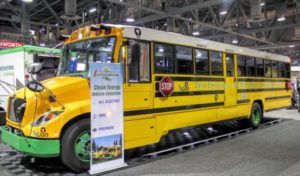Rural School Bus Pilot Program
Written by Sierra Huffman, CivicSpark Climate Fellow
Pack you lunch and grab your homework for here comes your new yellow ride! Schools throughout California are soon to be awarded with new electric, hybrid, and renewable diesel buses. In an effort to combat climate change and rising CO2 emissions, the California Energy Commission (CEC) and the North Coast Air Quality Management District (AQMD), along with the California Resources Board (CARB) have allocated funding to replace old school buses. The CEC and AQMD targeted school districts that previously had limited access to funding for equipment upgrades. The targeted school districts are located within rural, low income, or disadvantaged communities, with a priority on small districts.
Hybrid plug ins, renewable diesel, and battery-electric buses all present exciting opportunities for California’s schools. The selected school districts will have an opportunity to become shining examples of climate awareness though greenhouse gas abatement and improved air quality for younger generations. Additionally, with the inbound arrival of electric transportation, schools could become pioneers in the new age of electricity.
Electrified transportation could provide vehicle-to-grid or vehicle-to-building benefits through economic gains, accompanied by increased adaptation and resiliency for California’s schools. Zero emission buses are fundamentally big transportable batteries that can be plugged into the grid. The battery can suck-up energy from the grid when charging or export energy to the grid by discharging excess energy from the battery. One way this could be economic to school districts is through rate arbitrage. The school could charge the bus when energy is cheap and discharge energy to the grid, powering their electrical loads when energy is more expensive. Schools could use their new electric buses to power campus wide microgrids with the installation of grid islanding technology. The bus could serve as a backup battery, powering critical loads on campus during a power outage or natural disaster.
Furthermore, school districts could offset part or all of their electric transportation fuel costs with the installation of solar photovoltaic (PV) arrays. Solar PV arrays could provide 100% clean and emission free energy to loads on campus, which only enhances the benefits of the awarded electric buses.
Schools within California could become epicenters of electrical innovation and climate adaptation with the roll-out of low carbon buses. The new electric buses could provide electricity during emergencies, allow for decreases in monthly energy bills with rate arbitrage, improve air quality, reduce California’s greenhouse gas emissions, and allow schools to offset electrical energy costs by generating solar power on site.
The California Energy Commission and North Coast Air Quality District will release the names of the schools who will be receiving new buses in Spring 2019 and school districts should start receiving their buses by late Fall 2019. We are looking forward to an exciting year for California’s schools – the future is looking bright!
Local Government Commission Newsletters
Livable Places Update
CURRENTS Newsletter
CivicSpark™ Newsletter
LGC Newsletters
Keep up to date with LGC’s newsletters!
Livable Places Update – April
April’s article: Microtransit: Right-Sizing Transportation to Improve Community Mobility
Currents: Spring 2019
Currents provides readers with current information on energy issues affecting local governments in California.
CivicSpark Newsletter – March
This monthly CivicSpark newsletter features updates on CivicSpark projects and highlights.




